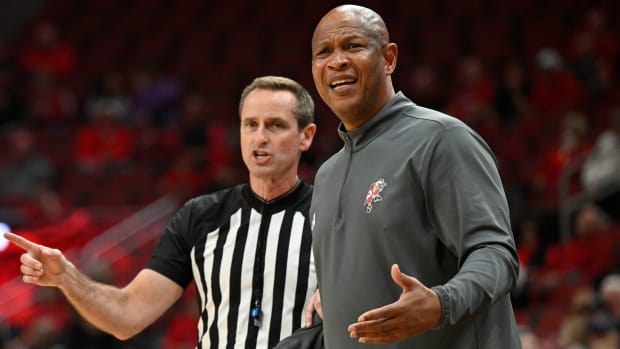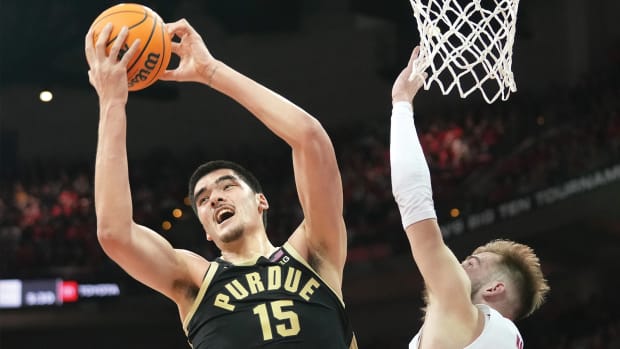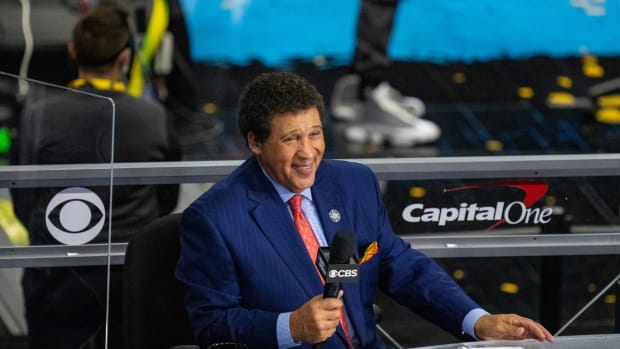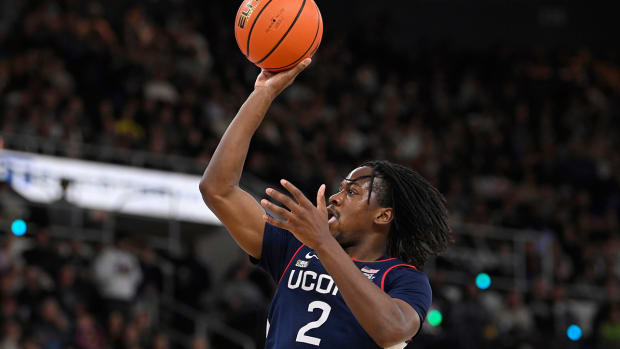The NCAA Supporting Athlete Compensation Is the Right Thing—and It's Time to Embrace It
It’s going to be a mess.
Do it anyway.
It’s going to be rife with abuse.
Do it anyway.
It’s going to be costly at a time when everyone associated with college sports is hemorrhaging money.
Do it anyway.
The NCAA is finally—finally!—coming out of Castle Amateurism and moving forward with tangible measures to allow compensation for student-athletes. That was the news Wednesday, as NCAA leadership announced its adoption of recommendations from a name, image and likeness working group that toiled for a year to start extricating college sports from the corner it had boxed itself into. Those recommendations are expected to be distilled into concrete bylaw proposals in October for an NCAA membership vote in January 2021, and presumptive implementation for the 2021–22 academic year.
(But no, there will be no return of the video game. That was shot down. Condolences.)
The NCAA has, to use one of its buzzwords from a one-hour teleconference, “modernized” its stance on players being paid. Congrats and all, but let’s be honest. Regardless of how this is framed, it was involuntary.
State legislators and sundry lawsuits forced the association into this seismic change in its forever stance. Now they’re hoping Congress provides a bailout with national legislation that trumps the state-by-state bills that would create chaos for an organization that runs on a single set of uniform rules.
Still: Whether the modernization is reluctant or willing no longer matters. The fact that it is happening matters. The fact that the NCAA is prepared to push forward despite an avalanche of side effects, consequences and problems is what matters.
“The difficulty of it doesn’t mean we can’t try,” said Big East commissioner Val Ackerman, a cochair of the NIL working group. That was the money quote Wednesday. That has to be the guiding NCAA principle while pushing this forward.
Ackerman, cochair Gene Smith (athletic director at Ohio State), NCAA president Mark Emmert and Ohio State president Michael Drake acknowledged—over and over—that there are a lot of details to work out and a lot of those details will be tricky.
How is this not a new gateway to rampant cheating?
How do schools and the NCAA allow boosters to be part of the compensation process without them overcompensating?
How do schools and the NCAA keep something that is supposed to be separate from the recruiting process from becoming a driving part of the recruiting process?
How do schools and the NCAA regulate agents, who are now going to be invited into the process?
How do schools and the NCAA track who gets what? How many new jobs need to be created at the university, conference and national levels to monitor who gets what? How many new jobs can be created at a time when schools, conferences and the NCAA are reducing staff, taking pay cuts, furloughing employees and preparing for further revenue shortfalls due to the COVID-19 pandemic?
Yeah, there are a lot of questions that do not lend themselves to easy answers. But for every potential problem at the micro level, there is one macro answer:
This is the right thing to do. So do it and deal with the mess as the new system slowly forms and takes hold and improves itself.
Trial and error is part of every major change, and there certainly will be more trial and error with an entity as resistant to change as the NCAA has been. But our society’s opinions have changed radically on the subject of paying college athletes, and it’s time to catch up with that change. Continuing to resist is both antiquated and fundamentally unfair.
When the college sports landscape was torn up and put back together a decade ago for the sole purpose of maximizing broadcast revenues, it was time to quit regarding this enterprise as amateur athletics. The Big Ten, SEC, ACC, Big 12 and Pac-12 realigned in ways that were damaging to rivalries and geographic sensibilities—but they made a bucket load of money, so why not?
If that was the acknowledge guiding principle of college sports, then it became increasingly untenable to prevent revenue-creating athletes from being part of the profit-making machinery. Now it’s time to correct that fundamental wrong.
Taking some of the eternal under-the-table payments to players above the table might be a legitimizing enterprise. All those SEC football players who seem to be driving late-model Dodge Chargers might actually now be paid to endorse local Dodge dealerships. The free meals and drinks that are everywhere for athletes in college towns might now be included in compensation for a star quarterback billboard for the popular local restaurant.
And while it’s easy to envision this being a boom to the power programs—Alabama boosters may line up for miles to get five-star quarterback commit Bryce Young as their product pitch man—it could work out well for the best football players at Boise State and Memphis, or the best basketball players at VCU or Saint Mary’s. Those programs have boosters and significant local followings, too.
So it’s time for everyone to embrace what’s coming. Problems and all, scandals and all, expenses and all. The NCAA has been forced to modernize, and it won’t mean the death of college sports as we know it.
It could be the birth of fairer and more legitimate college sports. Bring it on.
More From SI.com Sites:
Trevor Lawrence: The Face of the College Athlete?
What NCAA Endorsement Changes Would Mean for Duke
NCAA NIL Plan Couldn't Come At a Better Time for LSU




